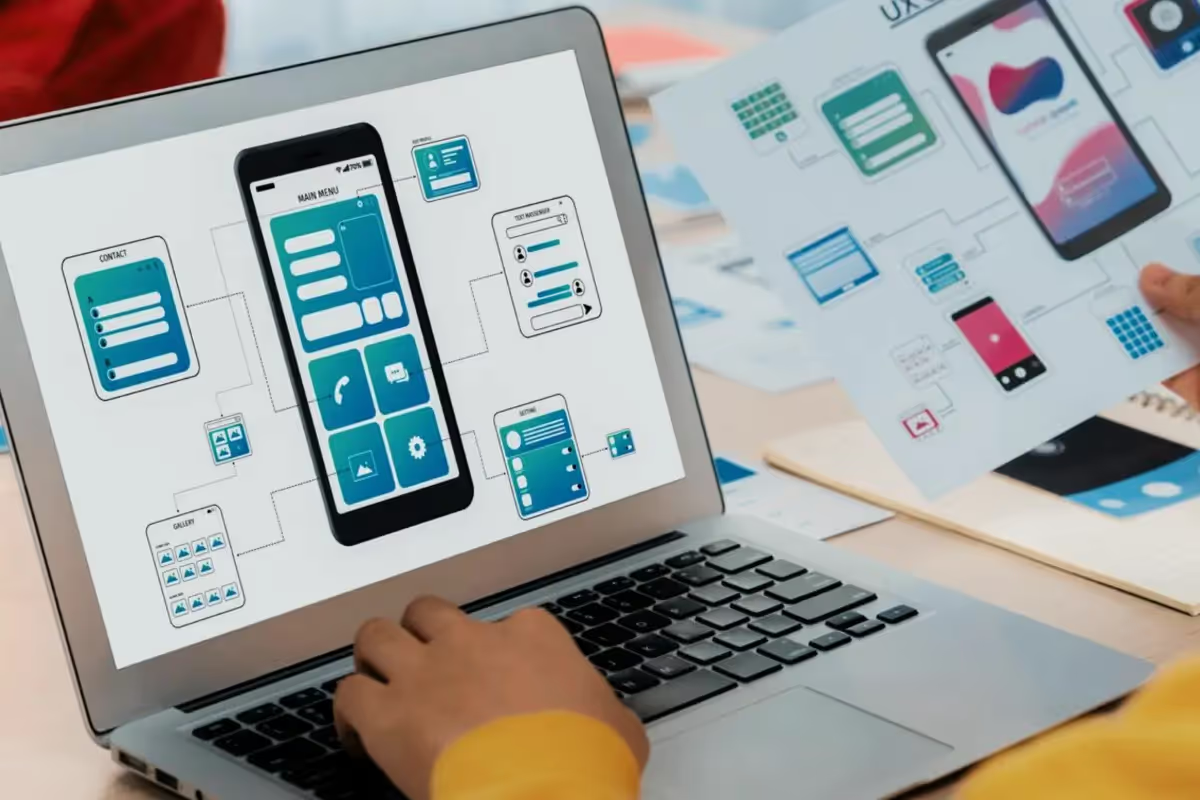These days, every software development lifecycle follows a string of steps that make the launch of high-quality software possible. Based on my professional experience, I can’t stress the importance of clearly defined steps in software development, whether for a budding startup or a mature corporate enterprise. A streamlined development process is the key.
As a Project Manager with ample experience in real estate, fintech, and healthcare projects, I am a big fan of a streamlined product development process. From my experience, I know how to make software development process steps work not only on paper.
So, in the article, we will look at the steps in the software development lifecycle and management methodologies available. If you do not have time to read a whole article, try taking our 10-step quiz “What's Your Software Development Methodology?”
I will also share my practical advice on implementing each step and try to give vivid examples from the experiences of popular businesses.
So, let’s dig right in!

What is Software Development Process?
Software development process (lifecycle) is a step-by-step lifecycle bringing a product’s concept from the ideation stage to implementation and eventually to the market. This is an iterative process aimed at matching real user needs and helping users achieve their objectives in the simplest way possible.
What Are The Steps of The Software Development Process?
Typically, the lifecycle includes:
- Requirements’ analysis
- Planning
- UX/UI Design
- Software development
- QA
- Deployment
- Maintenance and updates

The software development life cycle's main goal is to provide high-level software development within the determined timeline, budget and software development team structure. Thus, software development processes vary in different management methodologies, like Waterfall or Agile. Let's explore what the other 6 methodologies are!
6 Methodologies of Software Development Process
Today, besides more conventional Waterfall and Agile methodologies, plenty of other approaches offer a range of types of flexibility. We will cover the most popular and effective ones below and explain how they work.
For more detailed information about the main software development methodologies, please check our blog article 8 Best Software Development Methodologies.
Read on!
1. Waterfall Model: Reach Out to Perfection
The Waterfall software development model is a sequential software development process, where the direction of progress goes one direction downwards resembling a waterfall. This model is characterized by its linear approach, meaning that every step should be completed before the next one begins.
What are the steps of the Waterfall software development model?
The Waterfall model has the most straightforward and linear flow among other models, including the next steps:
- Requirement analysis
- System design
- Implementation
- Testing
- Deployment
- Maintenance

The advantage of the Waterfall model is its structured and streamlined nature. Yet, it is less flexible than an iterative or Agile.
2. Agile Methodology: Change and Adapt
The Agile software development process is an iterative and incremental process that prioritizes flexibility, customer satisfaction, and rapid delivery of software. The essence of the Agile approach is breaking down the project into smaller units, where each iteration involves a cycle of planning, designing, coding, and testing.
The idea behind the Agile model is to adapt to the ever-changing environment of the modern software development process by regularly collecting user feedback and integrating ongoing improvements.
What are the steps of the Agile software development process?
Here are a few typical steps of the Agile software development framework:
- Project planning
- Requirements analysis
- Design and development
- Testing
- Client feedback and iteration
- Release and maintenance

Drawing upon Agile methodology, it is perfect for dynamic and collaborative environments where client involvement is crucial. Its dynamic nature enables teams to embrace change and deliver products that match user needs.
3. Prototyping Development Model: Start With the Basics and Iterate
Prototyping is a model where the development team develops a basic prototype of the product to use for user tests on usability and feasibility of user flow. During those user tests, PMs gather feedback and make proper amendments for the product's following iterations until the prototype's best version is achieved.
Both Agile and Prototyping models are iterative approaches to software development. Yet, they differ as far as the project requirements and goals are concerned.
What are the steps of the Prototyping software development process?
The prototyping development process includes the following steps:
- Identifying basic requirements
- Developing the initial prototype
- User evaluation and feedback
- Refining the prototype
- Creating the final product
- Final testing and deployment

The prototyping method is excellent for crystalizing real user needs, gathering feedback, and eventually building more successful and user-friendly software solutions.
4. Incremental Development Model: Take it One Bite at a Time
The concept of the incremental development model is developing software in small portions to test it with users and gather their feedback. This is like multiple waterfall processes broken down into several iterations.
This model brings various benefits, like structured planning with flexibility. Allowing the break of large projects into smaller increments is a great option for managing complexity and risk.
What are the steps of the Incremental software development process?
The steps of the Incremental model development:
- Planning and requirement analysis
- Designing the first increment
- Development and testing
- Evaluation and feedback
- Developing subsequent increments
- Final integration and testing
- Deployment and maintenance

The Incremental model offers a strategic approach to the software development process, particularly for large-scale projects. It allows for regular improvement and flexibility to ever-changing conditions and requirements.
5. Iterative Development Model: Improve With Each Step
Among all the models mentioned here, the Iterative development methodology is the most flexible. The idea behind the iterative model is the gradual improvement of the product via generating consecutive versions and refining it based on feedback and corrections.
What are the steps of the Iterative software development process?
Steps of the Iterative software development process:
- Initial planning and requirement analysis
- Developing the first iteration
- Testing and evaluation
- Incorporating feedback and refining
- Repeating the cycle
- Final testing and deployment
- Post-deployment updates

Iterative development suggests a highly flexible methodology for the software development process. It encourages the development team to quickly respond to the changes and integrate corrections based on user feedback, ensuring the end product aligns perfectly with the actual user needs. Not only does iterative development contribute to the quality of the product, but it also enhances user satisfaction by involving them throughout the whole software development process.
6. Kanban Software Development Model: Visualize and Schedule
Kanban is another methodology of a software development process, originally used in Japan by Toyota as a scheduling system for lean manufacturing. The main principles of Kanban methodology focus on:
- Visualizing work
- Reducing work in progress
- Managing the workflow
- Prioritizing process transparency
- Implementing feedback corrections
- Fostering evolutionary change
What are the steps of the incremental software development process?
- Visualize the workflow
- Define work items
- Limit work in progress (WIP)
- Manage and optimize Flow
- Make process policies explicit
- Implement feedback loops
- Collaborative and evolving improvement

The main idea is to visualize the software development process to track the workflow via stages, for example: to do, in process, done. The visualization helps teams to better manage their tasks and improve efficiency.
Want to choose a software development methodology for your project specifically? Take this 10-question quiz that will help you pick a software development methodology that will work best for you (it is absolutely free and you’ll get your score immediately, no email required).
How to Develop a Software Project Step by Step?
Having looked at the diversity of software development methodologies, we want to guide you across how the development process looks at Uptech. Basically, we take Agile as the basics of our lifecycle. But, depending on the client’s requirements and project goals, we never hesitate to integrate the elements of other methodologies if it boosts our productivity and shortens time-to-market.
For example, we primarily focus on Agile during the development stage. But we can switch to Kanban for the Maintenance phase, where only minor changes are required.
Now I want to demonstrate a step-by-step software development process referring to Nomad – a real estate project that the Uptech team worked on and used all the nuances of Agile methodology.
The seven steps of the software development process include.
Let's explore explore!

Step 1. Gather Project Requirements
In the first step, it is important to gather all the functional and non-functional requirements of the product. To that end, at Uptech we run profound research including talking to stakeholders, interviewing users, and analyzing competitors and the market landscape of the niche.
At this point of the software development process, you want to make sure your product’s idea is based on a really existing user need, and your future software solves a real problem. To ensure that, make sure to validate your product's idea via a profound Discovery Stage. Interview your potential users, suggest solutions, run tests, and iterate.
Discovery was a central part at Nomad where we conducted dozens of interviews, and collected feedback throughout the whole process, improving the user experience at every step of the process.
Read more about How To Validate Your App Idea Without Development
So we build our hypotheses of user requirements but do not take them as truthful at once. Only after another series of interviews and user tests, we validate to cast off our assumptions, and finally come up with a list of real user requirements.
Building products ourselves, we know how to do qualitative requirements collection. We are happy to help you with that! With 150+ projects in our portfolio, we know how to do solid requirements collection optimizing your resources.
So do not hesitate to book a call with us via the form at the bottom of this article.
Step 2. Build a Project Roadmap
Based on the requirements gathered before, the Product/Project Manager goes on to build a Project Roadmap or a Software Development Plan, that will include the implementation steps.
Having a complete Roadmap on your table, you should also think of the resources required to implement the plan. In particular, think of how many Project Managers, Engineers, Designers, and QA Engineers you will need on your project team. And, of course, do not forget to count the expected budget.
Expert tip: What helped us to streamline the software development process at the Nomad project was tapping into the Triad Approach. The “triad” means that a Design, Project Management, and Developers team works together in ongoing cooperation for better synchronization and workflow.
As a result of the triad approach, we could build an MVP version fast, launch it, and add improvements for each following iteration. Working as a synchronized team, we removed loops for misunderstandings.
You can plan the number of project managers, software engineers, designers, tools, and technologies required for the project. Then, you need to create a flexible yet justifiable budget.
Step 3. Build UI/UX Design
During the design stage, the team starts with developing the visual solution of the product. This part of the process is known as User Interface Design, which represents how users perceive the app.
Thanks to the well-streamlined process of requirements collection, we managed to build a solid UX/UI design for the Nomad project.
Design is much more than only visuals. While the visual facade is essential for user engagement, functional and convenient user flow is crucial in whether a user stays with your app for long. The part of software design covering the convenience of user flow is called User Experience Design (UX Design).
To better illustrate the importance of solid UX design for app’s performance, let’s look at the outcomes of poor UX design:
- Complex navigation: By undermining the role of UX in software app development, you risk leaving your users distressed by challenging app flow and incomplete tasks.
- Bad App Performance: With poor UX, your app will take more time to load pages and perform requests, which is disrespectful to users’ time.
- Security concerns: The complexity of user flow can cause users to negate security features. For example, if a two-factor authentication takes too many steps, users might prefer to bypass them.
In contrast, let’s look at the outcomes of quality UX flow brings to the app’s performance:
- Intuitive flow. With a clean and straightforward interface user can achieve their goals much faster.
- Optimized performance. Good UX makes sure the app loads faster and performs more efficiently, saving users’ time.
- Accessibility for all users. A well-designed app includes voice commands, high-contrast modes, and easy-to-read fonts to cater to all users.
- Clear App Response: Every interaction with the app gives an instant reaction, leaving users relieved and satisfied.

The outcomes of a streamlined UX for your business are:
- Increased user satisfaction
- Cultivating user trust
- Higher user engagement

In conclusion, good UX plays a vital role in the performance and overall success of software products, fostering user engagement, enhancing user satisfaction, and, as a result, boosting business metrics.
Step 4. Start Software Development
In the third step, we finally begin coding the concepts listed above. Here, the development team implements all models, business logic, and service integrations specified in the prior stages.
The coding stage is usually the longest, as it is the cornerstone of the whole process. The development team follows the software requirements to build a product that lives up to the stakeholder’s expectations. If the previous stages were carried out thoroughly and the conditions were clear, the development stage should not be a problem.
The development stages proceed from alpha, beta, and release candidate to product build. Once the entire architecture (DB, API, etc.) and planned functionality of the solution are built, the testing stage starts.
The quality and productivity of the development stage depend on the tech stack chosen for the particular project. For example, for Nomad we used the following tech stack:
- BackEnd: Node.js language, Nest.js + Express, PostgreSQL database, Amazon S3.
- FrontEnd: Javascript language, React, RxObservable.
Step 5. Review Your Product at QA Stage
Once the development part is complete, you should run a reality check by performing QA testing. At the QA stage, the testing specialists discover and inform about the problems that arise while using the system. The testing frameworks may vary depending on the project, including automation and manual testing.
The testing phase is usually synchronized with the ongoing development. While the dev team generates the portions of content, the QA team runs tests, improving the software with each iteration.
Depending on the requirements of your project, the QA team will use a different type of testing. Here are the main types used in the software development process:
- Performance testing – This type of testing looks at how the system performs under certain conditions, measuring response time, scalability, reliability, and resource usage. It is usually performed to see if the system can process high loads and efficiently process large amounts of data. The best time to run performance tests is once essential features or functionalities have been launched.
Tools: LoadRunner, JMeter, Gatling. - Security testing. It is usually focused on detecting software vulnerabilities, threats, and risks to any malicious activities. Unlike performance testing, security assurance is usually run early in the software development process to ensure that potential threads are identified before the software is deployed. Additionally, security tests are also run throughout the whole development process.
Tools: OWASP ZAP (Zed Attack Proxy), Nessus, Burp Suite. - Unit testing is a method where separate units, like a function, process, or class test software. The idea behind this approach is to make sure each part of the software functions properly. Unit tests are usually written by developers and are performed along with the development process, ideally as part of a Test-Driven Development (TDD).
Tools: JUnit (for Java), NUnit (for .NET), Mockito (for Java). - Usability testing usually evaluates the software's usability and ease of use. The goal of usability testing is to ensure the software is intuitive, easy to navigate, and meets the users' needs. Usability testing is usually run iteratively along the whole software development lifecycle.
Tools: UserTesting, Lookback, Crazy Egg.

Step 6. Start Deployment
Once the development and QA testing phases are complete, deployment is the next step in the software development lifecycle. The goal of deployment is to finally put the software to use and deliver it to the intended audience. It takes a few stages to run deployment:
- Preparation and planning: scheduling, resource allocation, and contingency planning for potential risks.
- Final testing: a final pre-deployment round of testing to make sure there are no bugs and quality issues.
- Environment setup: configuring servers, databases, and other infrastructure.
- Release and launch: now it is time for actual software deployment, either gradual, where users gain access in portions, or a full launch where all users get access at once.
- Monitoring and troubleshooting: quick troubleshooting and resolution of the issues that might pop up.
- Feedback and updates: collect user feedback and make edits accordingly.

The deployment phase of the software development process is more than just a culmination of the whole lifecycle. A properly implemented deployment not only ensures smooth transitions but also sets the stage for the software's future adaptability and success.
For example, by running a portion-based release of the Aspiration app at the deployment stage, we managed to reach a 99% crash-free performance of the Aspiration Android app.
Step 7. Do Maintenance and Updates
The final, but recurrent phase of the software development process is providing maintenance and updates of the software. It involves a range of activities to ensure it continues to operate effectively, meets evolving user needs, and keeps up with the tech advancement.
Here are a few activities done during the maintenance stage:
- Monitoring and performance analysis: ongoing monitoring and analysis of performance metrics.
- Addressing Bugs and Issues: if when launched, bugs, issues, and crashes may pop up and intervene with users’ flow and app performance.
- Applying user feedback: user feedback is a rich source of insights on improving your app performance. Use it as a guide for future updates and enhancements.
- Security and compliance: as compliance requirements change, you should keep your app compliant with the ever-changing requirements.
- Enhancing Features and Functionality: to keep up with the market, software must evolve. Thus, adding new functionality and features is crucial after the release.
- Documentation update: while you’re updating your documentation, it is also important to add those updates to the documentation. Also, users might need training or new onboarding to use new features properly.
- Preventive maintenance: this phase requires regular checks and updates to prevent potential issues.

So here they are – 7 steps of the software development process. It takes a lot of versatile work, requiring tech, design, and management skills, streamlined processes, and communication.
Conclusion
A smooth software development life cycle is crucial to deliver a quality product that will meet the user's needs. Be it the classic Waterfall, flexible Agile, or any other methodology enlisted in the article, the focus on the software development process should remain on the user needs and solution of the central user problem.
At Uptech, we aim to make each of the development steps utmost productive and centered around the business needs. With 5 years of experience building products for early-stage startups, we know how to lead your idea from validation to complete realization of the business needs.
Contact us to discuss your idea and start a new journey together.
FAQs
What are the steps of product development lifecycle?
Typically, the product development lifecycle includes these steps:
- Requirements’ analysis
- Planning
- UX/UI Design
- Software development
- QA
- Deployment
- Maintenance and updates
How to develop a software product?
To build a software you need to pass these six steps of the software development process:
- Requirements Collection and Planning
- Build a Project Roadmap
- Create UI/UX Design
- Develop a software
- Run QA tests
- Deploy the product
- Maintain and update the product
What is software development lifecycle?
Software development process (lifecycle) is a step-by-step lifecycle bringing a product’s concept from the ideation stage to implementation and eventually to the market. This is an iterative process aimed at matching real user needs and helping users achieve their objectives in the simplest way possible.
What are the 6 methodologies of software development lifecycle?
Here are 6 main software development methodologies every product dev lifecycle includes:
- Waterfall model
- Agile model
- Prototyping model
- Incremental model
- Iterative model
- Kanban model



































































































.avif)
